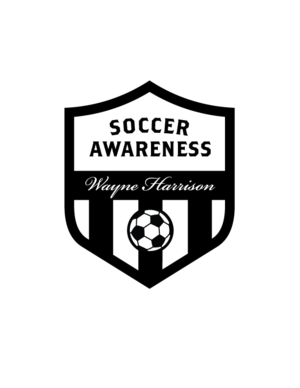Movements of the Wide Players Making Opposite Runs
/The following drill comes from Soccer Awareness eBook 34: Teaching Players How to Position OFF the Ball and to FACE FORWARD when Receiving It with Animation - Preview Here
CAN DO THIS WITH ATTACKING WING BACKS ALSO
Using CUES:
Cue for 7 and 11 is 6 and 8 passes, then to 7 or 11 then back to 6 or 8 then movement. Cue for 9 and 10 the same idea, to 9 or 10 then back to 6 or 8 then movements. Cue for fullbacks pass to 2 or 3, then back to 6 or 8 and as ball is travelling back, they make the movements.
SETUP
You can use the cones as an indicator if you like. Only seven players needed.
This is a Drill / Function keeping the movements simple.
Two 1 v 1 situations teaching both sides how to cut inside and receive a pass inside the defender.
Coaching Points:
Start position passing back and forth
Communication: Eye Contact / speech / pointing
Movement off the ball: timing and angle of the two-part run (faking the defender)
Quality of the Pass: Timing, angle and accuracy of the pass
Coordinated movements of the passer and receiver
Combination Play
Finish on goal
CUTTING INSIDE TO OUTSIDE RUN
Here we show a different run, generally the outside player cuts inside as the second and final run but here he makes the first run inside to cut outside on the second run and open a space up behind. Another opposite run; but going the other way; inside to outside.
Four Ideas of Movement to get Free:
Run him off and cut inside
Run towards the ball drawing the defender close then cutting across and inside of him
Run him inside to create space outside then check back outside
Run him away and outside away from the ball and then check back inside.
Players making all these different runs need to learn to check off both feet. (11) Running the defender off then checking inside checks inside off his left foot.
(11) Running towards the ball drawing the defender with him then checking across him and inside he is checking inside off his right foot.
CUTTING FROM OUTSIDE TO INSIDE RUN
Showing how the two wide players can cut inside to support the front two; now in a 4-2 against a 4-2 also (same as a lone striker situation but showing it can work in different formations).
One is going long, and one is coming short, but both can be effective, in fact the one coming short can be the best one as it draws the fullback away from the space behind. So, it is an opposite run.
The one going long means whilst you still lose him with the check inside, he is at least in a deeper defensive position to counter
Obviously the next phase would be to add the fullbacks and link them with the wide players creating 2 v 1 situations on the outside.
It is important to teach the wide players these outside to inside movements because they can be effective in many systems of play not just the 4-2-3-1 that we are focusing on in this book.
COMING SHORT TO GO LONG
Here we see a different way to get free of the defender, this time coming towards the ball and bringing the defender with him.
Once the defender is tight (11) cuts across his path and into the path of the pass in space in front of him. It is a very sharp cut not a looping cut that is easier to defend against.
3. Here the player breaks inside off his outside foot again, but in this case, it is the right foot. So, they need to learn how to do this checking movement off BOTH FEET.
IN TO EARLY
(11) goes in TOO EARLY and closes his OWN SPACE down.
By doing so he is marked by defender (A) and receives the ball with his BACK TO GOAL to feet and likely standing still.
This is ok because he still has possession and has his body between the defender and the ball to protect it, but he is facing backwards and away from the opponent's goal and not able to run at the defense. There are better situations he can get himself in to make it more difficult for the defender.
The pass inside and into the inside space now must be timing correctly so we need great understanding between the passer and the receiver; and this will only come by practicing this in training over and over until they get the timing; understanding and communication right.
Coaching Points:
Timing and accuracy of the pass (into SPACE INSIDE)
Timing of the run
Angle of the run
Timing of the pass: If it is too early then it may be intercepted; if it is too late then the player will receive it facing backwards as previously shown
Timing of the run: If it is too early then again, the player will receive it facing backwards as previously shown; if too late then the defender may get to the ball first.
Angle of the Run: Must be away from the defender and here I show two ways to do it as it is TWO RUNS not just one. First one to affect the defender and create space for himself the second one to exploit the space created.
Change In Tempo: Picking the right moments to do this.
GOING LONG TO COME SHORT
This is always if you have time to do this but try to run the defender away from the space you want to move into first. If you make the first run into that space, YOU WANT then you take the defender INTO IT with you.
Therefore you close your own space down for yourself and then may have to receive the pass facing backwards and to feet rather than into space facing forward. Still ok as we have possession but there are better solutions.
As shown here, you take the defender away and then check back and inside to receive the pass inside and therefore you are in a great position to be free of (A) and running at pace. Here you have received the ball facing backwards so your own MOMENTUM has stopped but you can still bring other players into play.
Here I show three options of a potential pass to maintain possession..
SO, THE TIMING AND ANGLE OF THE MOVEMENT IS THE KEY HERE.
MAKING TWO RUNS INSTEAD OF ONE (IF YOU HAVE TIME TO DO SO) MAY BE THE DIFFERENCE BETWEEN GETTING POSSESSION OR NOT OR RECEIVING
FACING FORWARD OR RECEIVING FACING BACKWARDS..
THE FORWARD RUN MAY EVEN BE A SIMPLE AS A CHECK FORWARD WITH ONE OR TWO STRIDES, GETTING THE DEFENDER OFF BALANCE;
THEN A CHECK INSIDE TO RECEIVE THE PASS.
122 Pages
These session plans show some ideas on how to position and instead “Face Forward” or FACE-UP or at least be Half Turned; or three quarters turned; rather than positioning square and facing back. This applies to any system / formation you use. Too Often players position to receive the ball with their back to play.
Simple movements can create more space for a player to then be at an advantage in their 1 v 1’s against opponents all over the field of play. It can be the difference between keeping the ball and losing it. Much is down to creating the correct Feet preparation and Body positions; angular not straight with regards to the ball. Open your hips up to give you the best peripheral vision available.



















